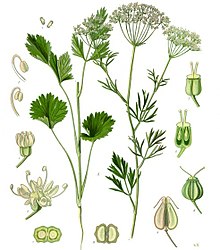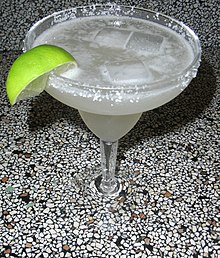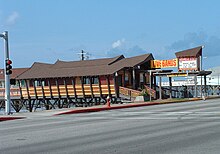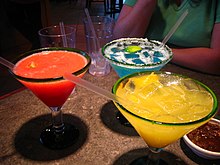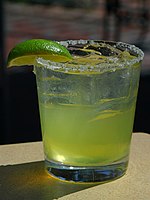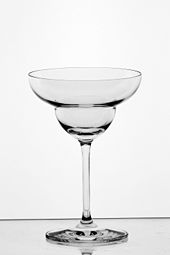From Wikipedia, the free encyclopedia
| Liquorice
|
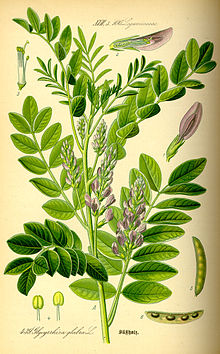
|
| Scientific classification
|
| Kingdom:
|
|
| (unranked):
|
|
| (unranked):
|
|
| (unranked):
|
|
| Order:
|
|
| Family:
|
|
| Subfamily:
|
|
| Genus:
|
|
| Species:
|
G. glabra
|
| Binomial name
|
Glycyrrhiza glabra
|
| Synonyms
|
- Glycyrrhiza brachycarpa Boiss.
- Glycyrrhiza glandulifera Waldst. & Kit.
- Glycyrrhiza hirsuta Pall.
- Glycyrrhiza pallida Boiss.
- Glycyrrhiza violacea Boiss.
|
Liquorice (
British English) or
licorice (
American English) (
LIK-ər-is(h)) is the common name of
Glycyrrhiza glabra, a
flowering plant of the bean family
Fabaceae, from the root of which a sweet, aromatic flavouring can be extracted.
The liquorice plant is a herbaceous perennial
legume native to the
Western Asia and southern Europe. It is not botanically related to
anise,
star anise or
fennel, which are sources of similar flavouring compounds. Liquorice is used as a flavouring in candies and
tobacco, particularly in some European and West Asian countries.
Liquorice extracts have been used in
herbalism and
traditional medicine. Excessive consumption of liquorice (more than 2 mg/kg/day of pure
glycyrrhizinic acid, a liquorice component) may result in
adverse effects, such as
hypokalemia, increased
blood pressure, and muscle weakness.
Etymology
The word "liquorice" is derived (via the
Old French licoresse) from the
Greek γλυκόριζα (
glykorrhiza), meaning "sweet root", from γλυκύς (
glukus), "sweet" and ρίζα (
rhiza), "root", the name provided by
Dioscorides. It is usually spelled "liquorice" in Commonwealth usage, but "licorice" in the United States.
Description
Chemistry
The scent of liquorice root comes from a complex and variable combination of compounds, of which
anethole is up to 3% of total volatiles. Much of the sweetness in liquorice comes from
glycyrrhizin, which has a sweet taste, 30–50 times the sweetness of
sugar. The sweetness is very different from sugar, being less instant, tart, and lasting longer.
Cultivation and uses
Liquorice,
which grows best in well-drained soils in deep valleys with full sun,
is harvested in the autumn two to three years after planting.
Countries producing liquorice include India, Iran, Italy, Afghanistan,
the People’s Republic of China, Pakistan, Iraq, Azerbaijan, Uzbekistan,
Turkmenistan and Turkey.
The world's leading manufacturer of liquorice products is
M&F Worldwide, which manufactures more than 70% of the worldwide liquorice flavours sold to end users.
Tobacco
Liquorice is used as a flavouring agent for
tobacco for flavour enhancing and moistening agents in the manufacture of American blend
cigarettes, moist
snuff,
chewing tobacco, and
pipe tobacco.
Liquorice provides tobacco products with a natural sweetness and a
distinctive flavour that blends readily with the natural and imitation
flavouring components employed in the tobacco industry. As of 2009, the US
Food and Drug Administration banned the use of any "characterizing flavors" other than menthol from cigarettes, but not other manufactured tobacco products.
Food and confectionery
Dried sticks of liquorice root
Liquorice flavour is found in a wide variety of
candies or sweets. In most of these candies, the taste is reinforced by
aniseed
oil so the actual content of liquorice is very low. Liquorice
confections are primarily purchased by consumers in Europe, but are also
popular in other countries such as Australia and New Zealand.
In the Netherlands, liquorice confectionery (
drop) is one of the most popular forms of sweets. It is sold in many forms. Mixing it with
mint,
menthol,
aniseed, or
laurel is quite popular. Mixing it with
ammonium chloride (
salmiak) is also popular as it is in Finland. A popular example of salmiak liquorice in the Netherlands is known as
zoute drop (
salty liquorice), but contains very little salt, i.e., sodium chloride. Strong,
salty sweets are also popular in
Nordic countries where liquorice flavoured alcohols are also popular, particularly in Denmark and Finland.
Dried sticks of the liquorice root are also a traditional
confectionery in their own right in the Netherlands as were they once in
Britain although their popularity has waned in recent decades. They
were sold simply as sticks of zoethout ('sweet wood') to chew on
as a candy. Through chewing and suckling, the intensely sweet flavour is
released. The sweetness is 30 to 50 times as strong as sucrose, without
causing damage to teeth. Since about the 1970s, zoethout has become rarer and been replaced by easier to consume candies (including 'drop').
Pontefract in
Yorkshire, England, was the first place where liquorice mixed with sugar began to be used as a sweet in the same way it is today.
Pontefract cakes were originally made there.
In County Durham, Yorkshire and Lancashire, it is colloquially known as
'Spanish', supposedly because Spanish monks grew liquorice root at
Rievaulx Abbey near
Thirsk.
In Italy (particularly in the south), Spain and France, liquorice
is popular in its natural form. The root of the plant is simply dug up,
washed, dried, and chewed as a mouth freshener. Throughout Italy,
unsweetened liquorice is consumed in the form of small black pieces made
only from 100% pure liquorice extract. In
Calabria a popular
liqueur
is made from pure liquorice extract. Liquorice is used in Syria and
Egypt, where it is sold as a drink, in shops as well as street vendors.
Research
Properties of
glycyrrhizin are under preliminary research, such as for
hepatitis C or
topical treatment of
psoriasis, but the low quality of studies as of 2017 prevents conclusions about efficacy and safety.
Traditional medicine
In
traditional Chinese medicine, a related species
G. uralensis (often translated as "liquorice") is known as "gancao" (
Chinese:
甘草; "sweet grass"), and is believed to "harmonize" the ingredients in a formula. Liquorice has been used in
Ayurveda in the belief it may treat various diseases, although there is no high-quality
clinical research to indicate it is safe or effective for any medicinal purpose.
Toxicity
The United States
Food and Drug Administration
believes that foods containing liquorice and its derivatives (including
glycyrrhizin) are safe if not consumed excessively. Other jurisdictions
have suggested no more than 100 mg to 200 mg of glycyrrhizin per day,
the equivalent of about 70 to 150 g (2.5 to 5.3 oz) of liquorice
confectionery. Liquorice should not be used during pregnancy.
Liquorice poisoning
Liquorice is an extract from the
Glycyrrhiza glabra plant which contains
glycyrrhizic acid, or GZA. GZA is made of one molecule of
glycyrrhetinic acid and two molecules of
glucuronic acid.
The extracts from the root of the plant can also be referred to as liquorice, sweet root, and glycyrrhiza extract.
G. glabra
grows in subtropical climates in Europe, the Western Asia, and Western
Asia. When administered orally, the product of glycyrrhetic acid is
found in human urine whereas GZA is not.
This shows that glycyrrhetic acid is absorbed and metabolized in the
intestines in humans. GZA is hydrolyzed to glycyrrhetic acid in the
intestines by bacteria.
For thousands of years
G. glabra has been used for medicinal purposes including indigestion and stomach inflammation.
Some other medicinal purposes are cough suppression, ulcer treatment,
and use as a laxative. Also, salts of GZA can be used in many products
as sweeteners and aromatizers. The major use of liquorice goes towards
the
tobacco industry, at roughly 90% of usage. The rest is split evenly between food and pharmaceutics, at 5% of usage each (
Federal Register,
1983). Liquorice extract is often found in sweets and many candies,
some drugs, and beverages like root beer. It can also be used in chewing
gum, tobacco products like snuff, and toothpaste.
An increase in intake of liquorice can cause many toxic effects.
Hyper-mineralocorticosteroid syndrome can occur when the body retains
sodium, loses potassium altering biochemical and hormonal activities. Some of these activities include lower
aldosterone
level, decline of the renin-angiotensin system and increased levels of
the atrial natriuretic hormone in order to compensate the variations in
homoeostasis.
Some other symptoms of toxicity include
electrolyte imbalance,
edema, increased
blood pressure,
weight gain, heart problems, and weakness. Individuals will experience
certain symptoms based on the severity of toxicity. Some other
complaints include fatigue,
shortness of breath,
kidney failure, and paralysis.
References article shows title only without any content to support claim.
Many adverse effects of liquorice poisoning can be seen and most
are attributed to the mineralocorticoid effects of GZA. Depending on the
dose and intake of liquorice, serious problems and even hospitalization
can occur. People with previously existing heart or kidney problems may
be more susceptible to GZA and liquorice poisoning.
It is important to monitor the amount of liquorice consumed in order to
prevent toxicity. It is difficult to determine a safe level, due to
many varying factors from person to person. In the most sensitive
individuals, daily intake of about 100 mg GZA can cause problems.
This is equivalent to 50 g liquorice sweets. However, in most people,
they can consume up to 400 mg before experiencing symptoms, which would
be about 200 g liquorice sweets. A rule of thumb is that a normal
healthy person can consume 10 mg GZA a day.






